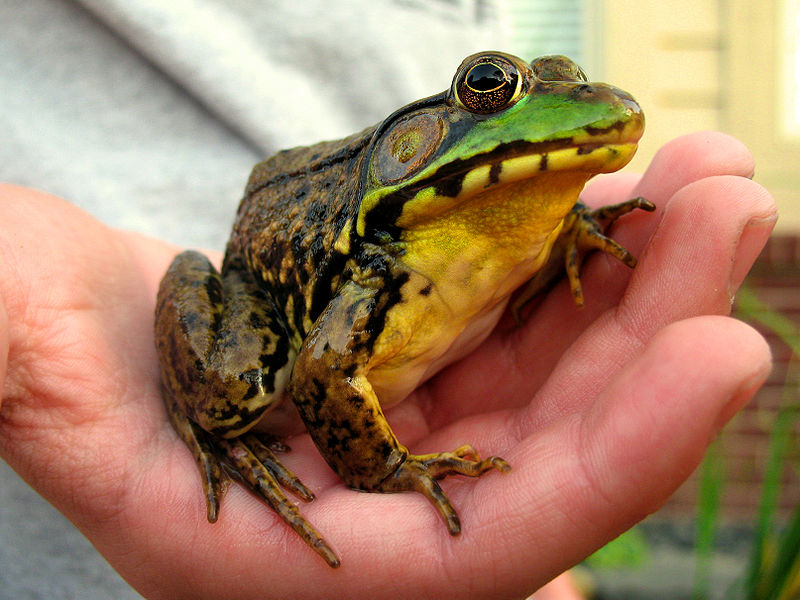
Green Frogs (Lithobates/Rana clamitans) and their tadpoles are often the first species to be collected by curious children exploring the great outdoors. They make hardy and interesting pets – so much so that experienced herp-keepers, myself included, often make room for a pair in their collections. Overlooking this fascinating frog because it is so common is a big mistake! Today I’d like to provide a short introduction, followed by care and natural history details next time. Read More »
Tag Archives: frogs in backyard ponds
Feed SubscriptionA Survey of Amphibians, Reptiles and Insects Suitable for Maintenance in Outdoor Ponds – Part I, The American Bullfrog, Rana catesbeiana (Lithobates catesbeianus)
Introduction
 An outdoor pond or other such habitat will expose you to facets of your pets’ behaviors that are difficult if not impossible to observe in indoor terrariums. I am a great fan of naturalistic, outdoor enclosures and from time to time will write about some of the many creatures that will thrive in them.
An outdoor pond or other such habitat will expose you to facets of your pets’ behaviors that are difficult if not impossible to observe in indoor terrariums. I am a great fan of naturalistic, outdoor enclosures and from time to time will write about some of the many creatures that will thrive in them.
Surprising Colonizers
In most cases, the animals within our terrariums have been put there on purpose. However, if you establish an un-fenced outdoor pond, you may be in for a few pleasant surprises, even in densely populated areas.
Surprisingly, creatures that seem incapable of moving great distances, such as frogs, salamanders, snakes and turtles, are actually quite adept at sensing the presence of new water sources and traveling to them.
Especially skilled in this regard are bullfrogs, leopard frogs, pickerel frogs, grey tree frogs, American toads, water snakes and snapping turtles. There is an incredible amount of pressure on young animals (in the form of territorial and hungry adults) to leave their natal homes, so it makes sense that they would be equipped with keen abilities to find new habitats. So surprising is the arrival of frogs at isolated ponds that, in earlier times, people believed they rained down from the sky or were spontaneously generated from the mud!
An Impressive Pond Resident
The American bullfrog, Rana catesbeianus, is the largest North American frog and a truly spectacular addition to the garden pond. Bullfrogs do not like to be crowded – most backyard ponds will support but 1 male and 1 or 2 females. Bullfrogs have large appetites and have been known to consume small birds, bats and mice, and especially favor smaller frogs (related or otherwise!) If you move about slowly and cautiously when the frogs are out sunning, they will soon accept your presence and will reward your patience by swallowing earthworms or crickets tossed nearby.
Introducing Bullfrogs to Your Pond
If you decide to add bullfrogs to an unenclosed pond, be sure to start with tadpoles – frogs introduced to a strange area will nearly always leave, apparently in search of their original homes. Tadpoles that mature in your pond will be quite content to stay nearby.
Bullfrog Tadpoles
The large tadpoles may take up to 2 years to mature. The tadpoles will eat whatever algae and dead insects they may find. However, they require a good deal of food for proper development, and should be given supplementary green vegetables that have be soaked for a few minutes in hot water (this breaks down the tough cell walls, which are indigestible) and held below water by rocks . Vegetables such as romaine, kale and dandelion are necessary foods when fish are about, as fish will out-compete the tadpoles for food items such as flakes and algae tablets.
Frogs in Winter
 Although bullfrogs and other temperate species can be over-wintered in the pond, it is safer to bring them indoors. They should be kept in a large aquarium with a good deal of cover in the form of floating plastic plants and enough water in which to submerged themselves, along with a smooth rock or piece of wood on which to rest. If kept at temperatures of 50 F or so (i.e. in a basement, if available), they will be fairly calm and will require but 1 weekly feeding. The Green Frog, Rana clamitans, and Leopard Frog, Rana pipiens, can be kept in small groups in outdoor ponds, as they are far less territorial than their larger cousin.
Although bullfrogs and other temperate species can be over-wintered in the pond, it is safer to bring them indoors. They should be kept in a large aquarium with a good deal of cover in the form of floating plastic plants and enough water in which to submerged themselves, along with a smooth rock or piece of wood on which to rest. If kept at temperatures of 50 F or so (i.e. in a basement, if available), they will be fairly calm and will require but 1 weekly feeding. The Green Frog, Rana clamitans, and Leopard Frog, Rana pipiens, can be kept in small groups in outdoor ponds, as they are far less territorial than their larger cousin.
The accompanying photo shows 2 female albino American Bullfrogs. Albino bullfrogs are striking additions to the outdoor pond, but will quickly be captured by predators if the pond is unenclosed. The animals pictured here are yearlings, and have a good deal of growing left to do.
 That Reptile Blog – Reptile, Amphibian and Exotic Pet Care and Information
That Reptile Blog – Reptile, Amphibian and Exotic Pet Care and Information
